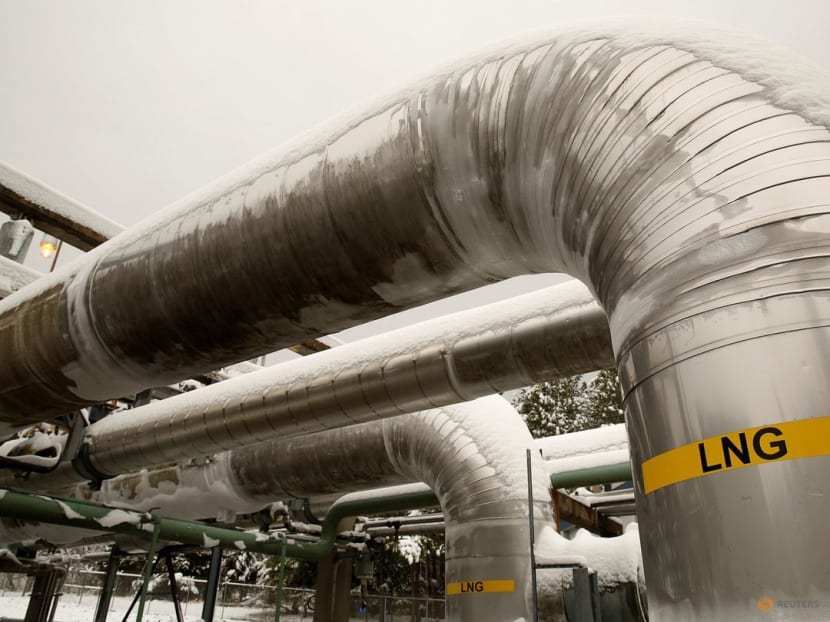Why are gas prices on the rise and what does this mean for Singapore?

FILE PHOTO: Snow covered transfer lines are seen at the Dominion Cove Point Liquefied Natural Gas (LNG) terminal in Lusby, Maryland on Mar 18, 2014. (Reuters/Gary Cameron)
SINGAPORE: A “perfect storm” of demand and supply factors is fuelling a historic surge in global natural gas prices, with benchmarks in Europe and the US up nearly 300 per cent and 100 per cent in recent months.
The rally may be here to stay for some time with lingering uncertainties in production and the coming winter set to push up demand.
A recent Reuters report described the gas market chaos as another potential headwind for a fragile global economy that is just getting back on its feet from a pandemic shock.
Economic consequences could be major, ranging from the risk of inducing a combination of slow growth and high inflation that is known as stagflation, a knock on consumer spending due to higher utility bills and increased pressure on some businesses, the report said.
Analysts are also keenly watching for any spillover impact into crude oil markets.
Here’s what we know:
WHAT HAPPENED?
A cocktail of complex factors causing a rise in demand and constrained supply has contributed to a “perfect storm” for natural gas prices, said Capital Economics.
In terms of demand, extreme weather events have led to longer-than-typical periods of cooling and heating, said the research firm’s head of global economics service Jennifer McKeown.
These include an unusually cold and prolonged northern hemisphere winter earlier this year, which left gas supplies depleted. While supplies would usually be replenished during summer, heatwaves and droughts in regions this year kept energy needs high.
A rebound from the COVID-19 pandemic has also ramped up demand from Asian economies, primarily in China, said the International Energy Agency (IEA), an industry watchdog based in Paris.
“All of these developments added to the upward trend in gas demand,” said the Paris-based agency in a statement on Sep 21.
Supply, on the other hand, has failed to keep up.
Production of liquefied natural gas (LNG) worldwide has been lower than expected due to a series of unplanned outages across the globe and maintenance of gas infrastructure which had been delayed due to the pandemic last year, said the IEA.
There were also reduced supplies from Russia, one of Europe’s main sources of gas.
Some have speculated that Russia is doing so to push for its Nord Stream 2 pipeline, which would deliver Russian gas directly to Germany and bypass Ukraine. Tensions have run so high that several European Parliament lawmakers have called for an investigation into what they said could be market manipulation by Russian gas giant Gazprom.
Gazprom has rejected the accusations, according to a Bloomberg report on Sep 24.
Stagnant wind farms have added to the supply woes, with IEA pointing to lower-than-usual availability of wind energy in Europe in recent weeks.
Capital Economics estimated that the European gas benchmark, Dutch TTF, has rallied 290 per cent since the start of the second quarter.
Asia LNG spot prices were up 260 per cent while US natural gas prices nearly doubled over the same period.
Related:
WHO’S AFFECTED?
Capital Economics' Ms McKeown expects a drag on activity in economies where higher utility prices will eat into consumers' income available for discretionary spending.
For instance, Reuters reported that 310,000 households in Germany will have an 11.5 per cent increase in gas bills.
There could also be adverse consequences for the energy sector, especially in countries where prices are regulated like the United Kingdom, Ms McKeown added in a note last week.
“But both effects should be mitigated by government policy, which is already seeking to shield households through taxes, subsidies and to support struggling businesses,” she said.
Spain’s Cabinet passed emergency measures earlier this month to redirect billions of euros in energy companies’ profits to consumers and capping increases in gas prices. Last week, Italy said it has set aside more than €3 billion (S$4.7 billion) to curb a spike in retail energy bills.
Still, anxiety is building about the possibility of other ripple effects.
“The impact on its own may not be that significant, but it is compounding the broader rise in inflation seen globally as supply bottlenecks and rising input costs feed through into core inflations,” Mr Scott Livermore, chief economist and managing director at Oxford Economics Middle East, told CNA.
Businesses already weakened by the protracted pandemic could also feel more pressure. Apart from energy providers, these could include fertiliser makers and even agricultural businesses.
For example, natural gas is used to create ammonia which in turn is a key component in many fertilisers. A report from ratings agency Fitch this week said fertiliser prices could remain elevated over the coming quarters, with a knock-on impact on crop yield and food prices.
France’s biggest sugar producer Tereos also warned that higher gas prices are increasing its production costs “tremendously”, said a Bloomberg report on Sep 10 citing a copy of an email from the company to clients.
The same Bloomberg report also noted that ceramic factories to steel businesses from China to Pakistan are feeling the heat.
Meanwhile in South Korea, state-run utility Korea Electric Power Corp has raised electricity prices for the first time in eight years in an attempt to offset the rise in gas prices, according to a report by the Korea Herald on Sep 23.
WHAT’S NEXT?
The IEA expects the European gas market to “face further stress tests from unplanned outages and sharp cold spells, especially if they occur late in the winter”.
Gas storage levels in Europe are “well below their five-year average”, although not markedly below the previous five-year low set in 2017, it added.
Ms McKeown from Capital Economics said natural gas prices will remain elevated for some time yet.
But prices should drop by the second quarter of next year, she said. This is because current prices will incentivise supply, particularly in the US where shale operations can ramp up relatively quickly. Prevailing prices may also help to curb demand.
“That said, the outlook for demand is highly uncertain as a key driver is the weather, where an unusually cold or mild winter would have an effect on gas prices,” said Ms McKeown.
Analysts are also watching to see if this could spill into crude markets and add momentum to an ongoing rally in oil prices. Already, the international oil benchmark Brent crude briefly topped US$80 a barrel this week, marking its first time since October 2018.
“Broader concern over tightness in energy markets, particularly for natural gas, is spilling over into the oil market,” said ING in a note this week.
“These higher gas prices will lead to some gas to oil switching, which would be supportive of oil demand.”
Related:
WHAT DOES THIS MEAN FOR SINGAPORE?
For Singapore, experts told CNA that surging gas prices will unlikely result in a direct hit to economic activity.
However, an uptick in electricity prices may be on the cards if the shortfall in gas supplies pushes global oil prices up.
While about 95 per cent of Singapore’s electricity is generated from imported natural gas, the prices of natural gas are indexed to oil prices, according to the Energy Market Authority which described this as the “market practice” in Asia for natural gas contracts.
As such, experts said movements in oil prices, instead of gas, tend to have a bigger impact on electricity prices here.
Ms Eileen Yan, Deloitte Singapore’s infrastructure and capital projects advisory partner, said: “If global energy – oil and gas – prices continue to increase, especially if natural gas prices spike further in the winter season due to increased heating needs, the electricity prices in Singapore would follow the trend as fuel costs are passed through to electricity prices.”
This, if it happens, will be felt more acutely by industries such as refinery, petrochemical, and transport and transportation, which use oil or natural gas as feedstocks or fuel. Businesses that are big electricity users, like data centres and shopping malls, may also expect more costly utility bills, said Ms Yan.
That said, any price increase in the cost of electricity will be gradual, according to Dr Ngin Hoon Tong, programme director at the Energy Research Institute of Nanyang Technological University.
This is because electricity tariffs here are calculated using the preceding quarter’s average fuel price, meaning lesser price volatility and a trickle-down effect that will likely kick in three months later.
SP Group said on Thursday (Sep 30) that the electricity tariff for households in Singapore will increase by an average of 3.1 per cent for the October to December period this year, compared with the previous quarter. This is due to the higher cost of fuel for producing electricity by the power generation companies, it said in a press release.
Overall, Barclays Bank economist Brian Tan said higher energy prices may have “some modest negative spillover effects on the Singapore economy, but these are unlikely to be large”.
Mr Livermore from Oxford Economics Middle East agreed that negative growth spillover will be limited given the small share of gas in Singapore’s trade.
“But should the gas prices translate into higher oil prices, it could have a more material impact as Singapore has one of the largest oil refinery industries globally.”
Mr Tan said while higher gas prices may push up Singapore’s core inflation gauge, which includes energy costs such as electricity and gas tariffs, it is unlikely to be a substantial increase.
“We doubt the Monetary Authority of Singapore will respond to an increase in core inflation that is largely driven by gas prices, especially as such commodity-driven inflation may prove to be transitory,” he said.






